Chapter 1 Videos: Introduction to Fluid Mechanics
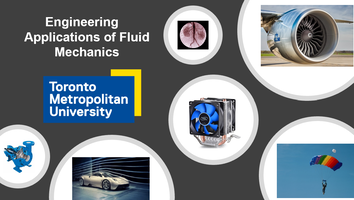
A General Introduction to Fluid Mechanics and Its Applications (11 min.)
Introduction to the engineering applications of fluid mechanics and an overview of how this course fits into your curriculum.
YouTube Video
Introduction to the engineering applications of fluid mechanics and an overview of how this course fits into your curriculum.
YouTube Video
| General Introduction to Fluid Mechanics (pdf) | |
| File Size: | 3728 kb |
| File Type: | |
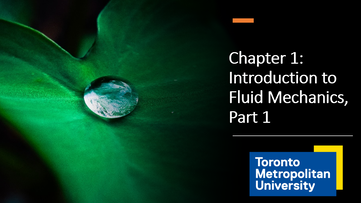
Part 1: Introduction to Fluid Mechanics (25 min.)
Some basic concepts in fluid mechanics: The technical definition of a fluid, the physical basis of pressure, the continuum approximation and the principle of dimensional homogeneity.
YouTube Video
Some basic concepts in fluid mechanics: The technical definition of a fluid, the physical basis of pressure, the continuum approximation and the principle of dimensional homogeneity.
YouTube Video
| Chapter 1 Introduction, Part 1 (pdf) | |
| File Size: | 2736 kb |
| File Type: | |
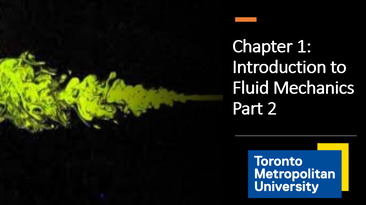
Part 2: Introduction to Fluid Mechanics (46 min.)
Continuing with basic concepts in fluid mechanics: The no-slip condition, fluid properties (density, specific gravity, specific weight, viscosity), Newton's law of viscosity and a calculation of viscous shear stress in a fluid, Newtonian and non-Newtonian fluids, laminar and turbulent flow and the Reynolds number.
YouTube Video
Continuing with basic concepts in fluid mechanics: The no-slip condition, fluid properties (density, specific gravity, specific weight, viscosity), Newton's law of viscosity and a calculation of viscous shear stress in a fluid, Newtonian and non-Newtonian fluids, laminar and turbulent flow and the Reynolds number.
YouTube Video
| Chapter 1 Introduction, Part 2 (pdf) | |
| File Size: | 4335 kb |
| File Type: | |
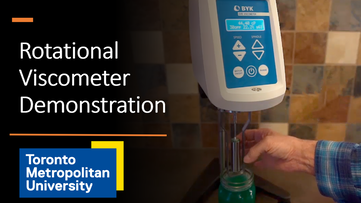
Rotational Viscometer Demonstration (10 min.)
Demonstration of the measurement of the dynamic viscosity of a Newtonian and Non-Newtonian fluid with a rotational viscometer. This video will also be helpful for understanding and writing your Lab 1 report.
YouTube Video
Demonstration of the measurement of the dynamic viscosity of a Newtonian and Non-Newtonian fluid with a rotational viscometer. This video will also be helpful for understanding and writing your Lab 1 report.
YouTube Video

Solved Example Problem: Dimensional Consistency (9 min.)
Solved problem showing the dimensional consistency of Stokes' equation. This type of analysis is important for Chapter 5 (Dimensional Analysis).
YouTube Video
Solved problem showing the dimensional consistency of Stokes' equation. This type of analysis is important for Chapter 5 (Dimensional Analysis).
YouTube Video
| Solved Example: Dimensional Consistency (pdf) | |
| File Size: | 369 kb |
| File Type: | |
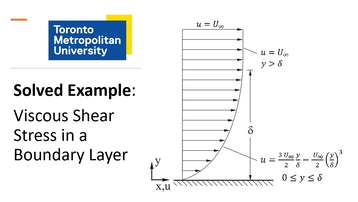
Solved Example: Shear Stress in a Boundary Layer (14 min.)
An example of calculating the viscous fluid shear stress in a boundary layer flow using Newton's Law of Viscosity.
YouTube Video
An example of calculating the viscous fluid shear stress in a boundary layer flow using Newton's Law of Viscosity.
YouTube Video
| Solved Example: Viscous Shear Stress in a Boundary Layer (pdf) | |
| File Size: | 1281 kb |
| File Type: | |
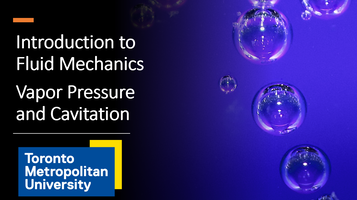
Part 3: Introduction to Fluid Mechanics (12 min.)
More basic concepts in fluid mechanics: Vapor Pressure and Cavitation.
YouTube Video
More basic concepts in fluid mechanics: Vapor Pressure and Cavitation.
YouTube Video
| Chapter 1 Introduction, Part 3 (pdf) | |
| File Size: | 3096 kb |
| File Type: | |
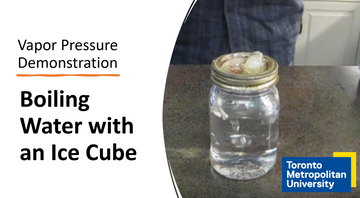
Vapor Pressure Demonstration (5 min.)
A demonstration of how to make a container (mason jar) of saturated water. This saturated mixture will boil at low temperature when vapor is condensed onto the lid using an ice cube. This is a demonstration of the action of vapor pressure.
YouTube Video
Vimeo Video (Ad-free)
A demonstration of how to make a container (mason jar) of saturated water. This saturated mixture will boil at low temperature when vapor is condensed onto the lid using an ice cube. This is a demonstration of the action of vapor pressure.
YouTube Video
Vimeo Video (Ad-free)
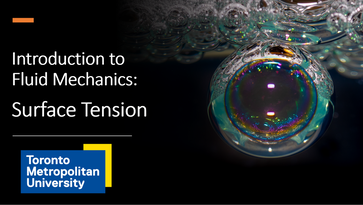
Part 4: Introduction to Fluid Mechanics (18 min.)
More basic concepts in fluid mechanics: Surface Tension and Capillary Effects.
YouTube Video
More basic concepts in fluid mechanics: Surface Tension and Capillary Effects.
YouTube Video
| Chapter 1 Introduction, Part 4 (pdf) | |
| File Size: | 4286 kb |
| File Type: | |
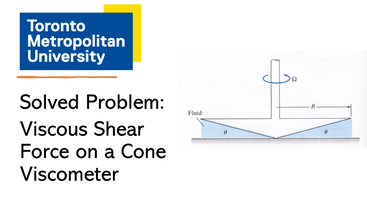
Solved Example Problem: Viscometer (15 min.)
Solution of a problem involving the calculation of the viscous shear stress of a fluid on a rotating cone. There is also a short video at the end, showing a commercial viscometer. This is a relatively difficult problem.
YouTube Video
Solution of a problem involving the calculation of the viscous shear stress of a fluid on a rotating cone. There is also a short video at the end, showing a commercial viscometer. This is a relatively difficult problem.
YouTube Video
| Solved Example: Cone Viscometer (pdf) | |
| File Size: | 325 kb |
| File Type: | |
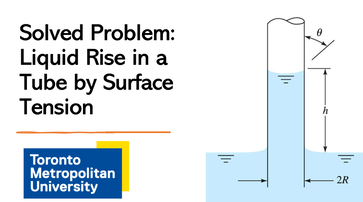
Solved Example Problem: Capillary Tube (15 min.)
Solution of a problem involving "capillary action". The problem involves calculating the height that the water is drawn up a tube by the surface tension force. There is also a discussion of how to calculate the capillary effect between two long parallel plates.
YouTube Video
Solution of a problem involving "capillary action". The problem involves calculating the height that the water is drawn up a tube by the surface tension force. There is also a discussion of how to calculate the capillary effect between two long parallel plates.
YouTube Video
| Solved Example: Capillary Tube (pdf) | |
| File Size: | 165 kb |
| File Type: | |
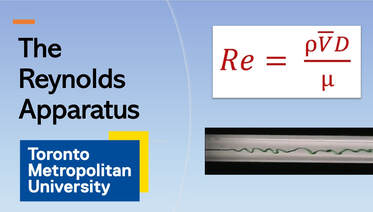
The Reynolds Apparatus (8 min.)
This video discusses the Reynolds number and Osbourne Reynolds' famous experiment to characterize laminar to turbulent flow transition in a smooth pipe. The Reynolds Apparatus is used to visualize laminar and turbulent flow in a round smooth pipe. This video is also a supplement to Lab 2.
YouTube Video
This video discusses the Reynolds number and Osbourne Reynolds' famous experiment to characterize laminar to turbulent flow transition in a smooth pipe. The Reynolds Apparatus is used to visualize laminar and turbulent flow in a round smooth pipe. This video is also a supplement to Lab 2.
YouTube Video
| The Reynolds Apparatus.pdf | |
| File Size: | 1936 kb |
| File Type: | |
Optional Chapter 1 Videos
These optional videos are for interest only. They are related to fluid mechanics. They are not part of the test material.
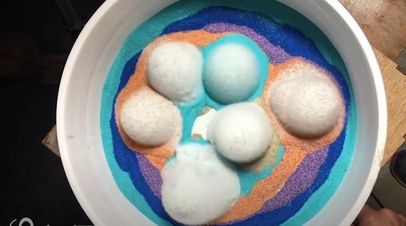
Fluidized Beds (8 min.)
Optional supplemental viewing, which I think you will find fascinating. I discuss in my in-person lecture course -- the slides are given below. Bubbling air through sand can cause it to act like a liquid. In other words, the sand cannot resist shear stress. Fluidized beds are widely used in industry to promote chemical reactions, for heat treatment, for drying, for the combustion of coal, etc.
YouTube Video
Optional supplemental viewing, which I think you will find fascinating. I discuss in my in-person lecture course -- the slides are given below. Bubbling air through sand can cause it to act like a liquid. In other words, the sand cannot resist shear stress. Fluidized beds are widely used in industry to promote chemical reactions, for heat treatment, for drying, for the combustion of coal, etc.
YouTube Video
| Concept Quiz w/ Fluidized Bed Video (pdf) | |
| File Size: | 612 kb |
| File Type: | |
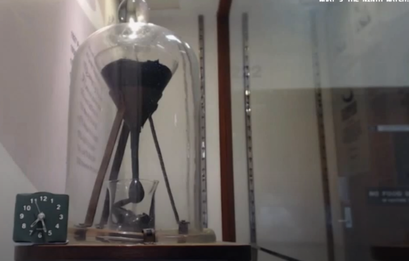
The Pitch Drop Experiment (3 min.)
Optional supplemental viewing, which I discuss in my traditional lecture course. "Pitch" is a more solid version of tar. Is "solid" pitch a fluid? The world’s longest running laboratory experiment demonstrates that it is!
YouTube Video
Optional supplemental viewing, which I discuss in my traditional lecture course. "Pitch" is a more solid version of tar. Is "solid" pitch a fluid? The world’s longest running laboratory experiment demonstrates that it is!
YouTube Video
| Pitch Drop Experiment (pdf) | |
| File Size: | 959 kb |
| File Type: | |

Breaking a Beer Bottle using Cavitation (4 min.)
Optional supplemental viewing. I do this physical demonstration in my in-person lecture course. One of my favorite videos, which shows how to break the bottom out of a beer bottle using cavitation. The high-speed (slow motion) video is starts at 1:46. Notice the vapor bubble that forms in the water at the bottom of the bottle -- because the local pressure falls below the vapor pressure of water at room temperature. This vapor bubble collapses so quickly and forcefully that it breaks the bottom out of the bottle. If you try this, be sure to wear thick gloves!
YouTube Video
Optional supplemental viewing. I do this physical demonstration in my in-person lecture course. One of my favorite videos, which shows how to break the bottom out of a beer bottle using cavitation. The high-speed (slow motion) video is starts at 1:46. Notice the vapor bubble that forms in the water at the bottom of the bottle -- because the local pressure falls below the vapor pressure of water at room temperature. This vapor bubble collapses so quickly and forcefully that it breaks the bottom out of the bottle. If you try this, be sure to wear thick gloves!
YouTube Video
Toronto Metropolitan University


